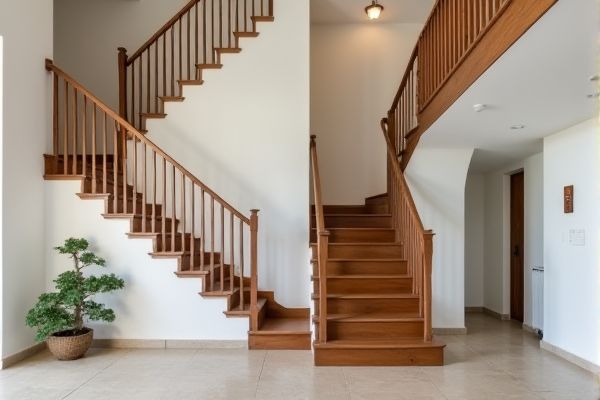
Dual function stairs optimize space by combining stair access with additional features like storage or seating, enhancing both usability and design efficiency. Explore the article to discover how your choice between dual function and single purpose stairs can transform your living space.
Table of Comparison
| Feature | Dual Function Stairs | Single Purpose Stairs |
|---|---|---|
| Definition | Stairs serving two functions, such as access and storage or seating | Stairs designed exclusively for vertical movement |
| Space Efficiency | Maximizes space by combining functions | Dedicated space only for stair usage |
| Cost | Higher initial cost due to complex design | Generally lower cost with simple design |
| Complexity | Requires careful planning and construction | Simple construction and installation |
| Functionality | Multi-use: access plus additional function (storage, seating) | Single-use: vertical movement only |
| Safety | Potential safety concerns due to added functions | Standard safety features focused on stair use |
| Examples | Stairs with built-in drawers, seating step stairs | Traditional straight or spiral stairs |
Introduction to Staircase Design: Dual Function vs Single Purpose
Dual function stairs serve both as a means of vertical circulation and as functional spaces such as storage, seating, or display, maximizing spatial efficiency in architectural design. Single purpose stairs focus solely on facilitating movement between floors, often emphasizing straightforward construction and safety standards. Integrating dual function stairs enhances usability and aesthetic value, while single purpose stairs prioritize simplicity and compliance with building codes.
Defining Dual Function Stairs
Dual function stairs serve both as a traditional staircase and an alternative utility, such as storage or seating, enhancing space efficiency in architectural design. Unlike single-purpose stairs designed solely for vertical movement, dual function stairs integrate multi-use features without compromising safety or accessibility. These stairs are ideal for compact living spaces, combining structural integrity with innovative functionality.
What Are Single Purpose Stairs?
Single purpose stairs are designed exclusively for vertical movement between floors, serving only as a means of access or egress without additional functionality. These stairs prioritize straightforward, efficient navigation and often lack features like integrated storage or seating. Understanding the role of single purpose stairs helps you evaluate whether a more multifunctional dual function stair might better suit your space and needs.
Space Optimization: Multifunctional vs Traditional Stairs
Dual function stairs integrate storage, seating, or shelving within the staircase structure, maximizing usable space and reducing clutter in small or multifunctional rooms. Traditional single purpose stairs occupy a fixed footprint solely for vertical movement, often limiting design flexibility and underutilizing available square footage. Utilizing multifunctional stair designs enhances space optimization by combining practicality and aesthetics, a critical advantage in compact living environments.
Aesthetics and Style Considerations
Dual function stairs enhance interior aesthetics by combining functionality with design elements such as built-in storage or integrated lighting, creating visually appealing, space-efficient solutions. Single purpose stairs often emphasize traditional craftsmanship and straightforward style, offering clean, minimalistic lines suited for classic or modern decor. Choosing between the two depends on the desired architectural impact and complementary decor themes within the living space.
Cost Comparison: Installation and Maintenance
Dual function stairs typically involve higher initial installation costs due to their complex design and materials required for multi-purpose use, while single purpose stairs are generally more economical to install with straightforward construction. Maintenance expenses for dual function stairs may increase because of specialized components and more frequent inspections necessary to ensure safety and functionality across different uses. Evaluating your long-term budget, single purpose stairs offer lower ongoing costs, but dual function stairs can provide enhanced utility that might justify the higher investment.
Safety and Building Regulations
Dual function stairs that combine safety features with aesthetic design often exceed building regulations by incorporating handrails, non-slip surfaces, and proper riser heights, enhancing user safety effectively. Single purpose stairs, while meeting basic safety codes, may lack multifunctional elements that improve accessibility and emergency evacuation. Ensuring your stairs comply with local building regulations promotes safety and legal adherence in both residential and commercial environments.
Practical Applications and Use Cases
Dual function stairs combine staircase and storage or seating, optimizing limited spaces in small apartments, lofts, and tiny homes by enhancing functionality without increasing footprint. Single purpose stairs serve primarily for vertical movement, ideal for commercial buildings and public spaces where safety and code compliance are paramount. Your choice depends on space availability and specific needs, balancing utility and design.
Environmental Impact and Sustainability
Dual function stairs, integrating storage or green spaces, maximize material efficiency and reduce overall resource consumption compared to single purpose stairs, which use space solely for transit. Utilizing sustainable materials and multifunctional designs in dual function stairs lowers carbon footprints by decreasing the need for additional furniture or building elements. This approach supports circular economy principles, enhancing environmental sustainability through waste reduction and improved space utilization in architectural design.
Choosing the Right Staircase for Your Space
Dual function stairs maximize space efficiency by combining storage or seating with traditional stair use, ideal for small homes or tight areas. Single purpose stairs focus solely on safe, straightforward vertical movement, best suited for areas where space is not a constraint. Assess your room size, storage needs, and design goals to determine whether multifunctional stairs enhance utility or a simple staircase meets your requirements.
 homyna.com
homyna.com